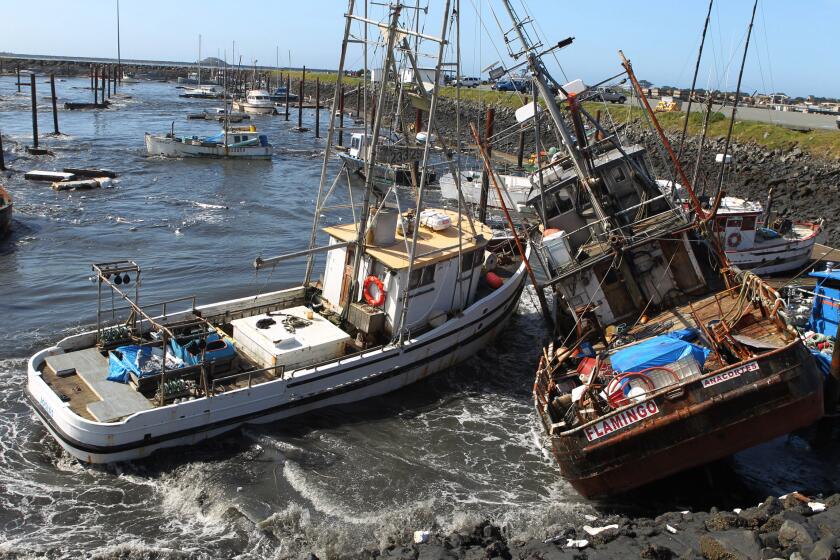Lessons of a Quake That Didn’t Happen : Geology: The long-predicted Parkfield temblor failed to occur in 8-year period. But scientists say that some monitoring procedures have become established in the state and that much was learned.
- Share via
It’s official: The long-predicted Parkfield earthquake did not happen, but scientists and state emergency officials continuing to study the 25-mile segment of the San Andreas Fault near that Central California hamlet say a lot was accomplished during the watch for it.
An eight-year period, during which U.S. Geological Survey scientists set a 95% likelihood of a 6 magnitude temblor occurring, expired with the ringing in of the new year. But the instrumentation and on-scene monitoring of the Parkfield area will go on at least until Oct. 1, the end of the federal fiscal year.
“The assumptions that went into our hypothesis were wrong,” acknowledged John Langbein, the geophysicist who was the last of several scientists in charge of the prediction experiment, which cost about $20 million.
“But Parkfield is still the most likely place on the San Andreas for a 6 magnitude earthquake. If we get an earthquake in 1998, it will simply mean that our original model was off base as to the timing.”
Regardless of when the quake occurs, Langbein and Richard Andrews, director of the state Office of Emergency Services, said last week that some procedures worked out in the Parkfield experiment have become established in the state. These include mechanisms for alerting the public on shorter-term quake probabilities, when smaller earthquakes occur as possible foreshocks to larger ones.
At Parkfield, federal and state officials developed criteria for issuing such alerts. When a 4.7 earthquake struck the area on Oct. 19, they automatically issued a warning to a seven-county area in Central California that there was a 37% chance that a 6 magnitude temblor would strike within 72 hours.
It did not happen, but Langbein observed, “The sociological problem we’ve started to tackle with Parkfield is communicating hazards to the public, and gauging the public reaction to such warnings.
“Parkfield has been a very nice laboratory for this,” he said, adding that scientists will apply the model for alerts to the rest of the state. “We have it at work now in Southern California and the Long Valley Caldera at Mammoth Lakes. So that’s one product of the experiment.”
Andrews recently disclosed that the state has plans to issue an imminent-quake alert to Southern California for a possible Big One of 7.5 magnitude or greater, should there be a 6 magnitude shock along the southern San Andreas in what is believed to be a quake-prone area between San Bernardino and the Salton Sea.
Last week, he expressed hope that instrumentation of the Parkfield area would continue, so that when a moderately strong earthquake does occur there, there will be a good chance of closely studying any precursors to it and reviewing precisely what happens during the quake.
This was one of the goals of the experiment: to so carefully instrument an area where the odds of relatively frequent quakes are high that scientists might better learn the mechanics of such events when they do occur.
Despite the failure of the quake to happen during the period expected, scientists remain interested in the sparsely populated Parkfield area, roughly midway between Los Angeles and San Francisco, because it was the scene of 6 magnitude quakes at fairly regular intervals over a 109-year period between the mid-19th and mid-20th centuries.
There were such jolts in 1857, 1881, 1901, 1922, 1934 and 1966. Based on the average 22-year interval, many scientists felt very confident that a similar quake would occur in the area within four years, either way, of 1988, and that was the genesis of the Parkfield prediction experiment.
In recent months, however, researchers at Harvard University and UC Santa Cruz have suggested that either there was not enough historic record to make such assumptions, or the interval may be lengthening.
Last month, for example, Steven Ward at UC Santa Cruz said, “If you have less than about 10 events, things tend to look more periodic than they really are.” He contended that the real probability of a 6 magnitude Parkfield quake between 1985 and the end of 1992 should only have been placed at 32%.
Two other prominent quake scientists, Amos Nur at Stanford University and Hiroo Kanamori, director of the Caltech Seismological Laboratory, have recently questioned the assignment of precise quake probabilities to any locale, saying that not enough is known about the mechanics of earthquakes to reliably make such estimates.
Langbein said he is philosophical about the expiration of the eight-year “window of probability” at Parkfield.
“When I walked into this, I sort of realized that 95% was really a pretty optimistic window,” he said. “Given the uncertainties and assumptions that went into it, it was a pretty bold hypothesis.”
More to Read
Sign up for Essential California
The most important California stories and recommendations in your inbox every morning.
You may occasionally receive promotional content from the Los Angeles Times.













